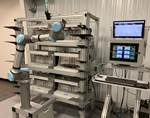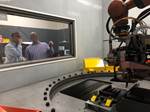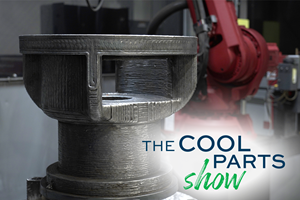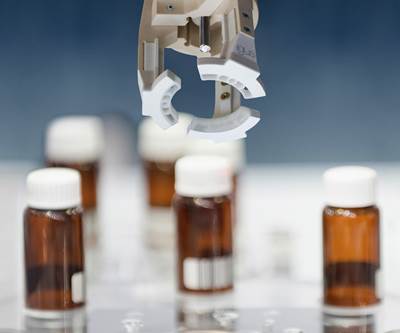Robotic automation and additive manufacturing (AM) both have the potential to transform how parts get made and how businesses operate. The addition of a cobot or other robot allows a business like a machine shop to devote less human attention to tasks such as loading and unloading workpieces; this move might then lead that business to pivot to lights-out production for greater productivity. Likewise, a manufacturer might add 3D printing capability to make jigs and fixtures, but later discover its applicability for producing end-use parts and find new business opportunities there.
Yet robots and additive manufacturing do not run in parallel tracks. Their paths frequently intersect, often to great advantage. Here are four ways that robots and 3D printing support and enable each other:
1. 3D Printed End-of-Arm Tooling (EOAT)
Vacuum grippers, jaws and other end-of-arm tools for robots are a perfect application for the design freedoms 3D printing offers. 3D printing makes it possible to build functional grippers in just one piece, incorporating air lines, live hinges and other complex features without assembly (see below). Topology optimization strategies or simply the chance to create robot tooling out of plastics versus metals can provide weight savings, preserving more of the robot’s payload for the parts. Bringing robot tooling in-house via 3D printing is also an affordable option for producing these items, with potential time savings to boot.
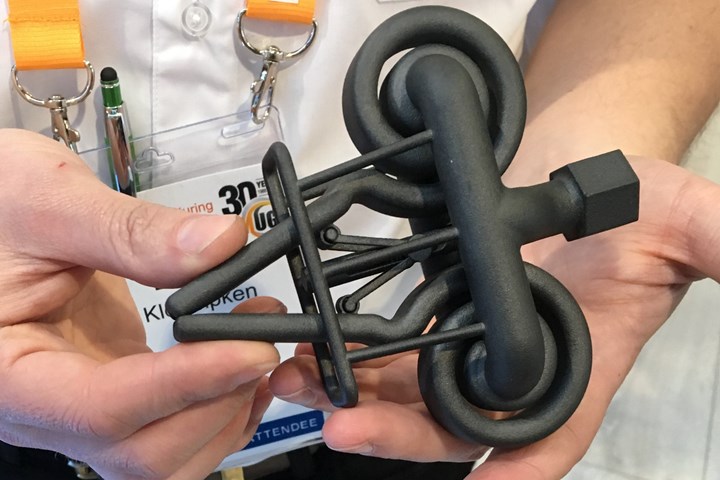
This robot gripper made by IAM 3D Hub through Multi Jet Fusion demonstrates how moving parts can be incorporated into a 3D printed end effector. A pneumatic mechanism operated via shop air squeezes the jaws closed as shown here. More.
2. 3D Printed Off-Robot Accessories
Of course, the robot end effector is only one piece of the overall system needed to automate a given operation. Custom trays, jigs, fixtures and more may be needed to serve up parts in just the right way to the robot, or to collect parts after they have been processed. Here again, 3D printing provides a fast, simple way of building creative solutions around the robot automation which can be done in-house with an affordable polymer printer.

Superior Metal Products designed and 3D printed this collection chute to allow for manual part inspection without stopping the operation of its automated turning cell. More. Photo Credit: Superior Metal Products
3. Robot-Tended 3D Printers
There are also ways for 3D printing to benefit from integration with robotics. The additive manufacturing process consolidates various workflow steps into one machine that can run unattended for long periods of time. Rather than time shifts and adjust schedules to accommodate 3D printer unloading, manufacturers can use robots to remove finished parts, place new build plates, and continue printing even when no humans are present.
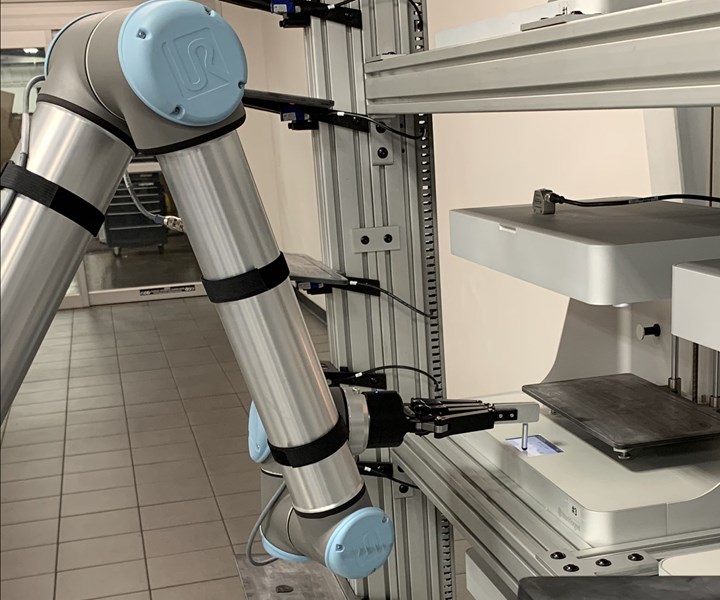
This cobot at plastics manufacturer Evco tends a bank of polymer 3D printers that produce tooling as well as end-use parts. When a build complete, the robot removes the part, places a fresh build plate in the printer, and uses a stylus (pictured) to start the print cycle again. More.
4. Robots As 3D Printing Systems
In addition to being a valuable means of moving parts and supplies, robots can also serve as the method for applying material in a 3D printing process. Options for robotic 3D printing include polymer extrusion, wire arc additive manufacturing, metal powder directed energy deposition (DED) and even heat-free supersonic deposition. A 3D printing head mounted on a robot arm has more freedom of motion than one fixed in a gantry, and can enable support-free 3D printing and complex geometries that might not otherwise be possible. (The reverse is also possible — that is, keep the printhead stationary but mount the build plate on a robotic arm for geometric freedom.) Robots can also be mobile, and can achieve a much larger effective build volume by being mounted on a track or moved on site to produce structures in situ. Multiple 3D printing robots can even be coordinated to print together, operating in a swarm or a choreographed dance to speed production and create large parts more quickly.

Addere has developed a robot-based directed energy deposition (DED) system for 3D printing of large metal components. The laser-based process works in an enclosed environment, monitored by cameras in an adjacent room. More.
3D Printed Conveyor Mat Aids Robot Automation
Another example of a connection between additive manufacturing and robots involves a 3D printed conveyor mat at the heart of a system for robotic part handling. On The Cool Parts Show, learn more and see the 3D printed vibratory separator mat in action.
Related Content
3D Printed End of Arm Tooling Aids Automation
Frustrations with traditional end of arm tooling led Richard Savage to start 3D printing custom versions for injection molding applications, eventually founding a company to fill this niche.
Read MoreMosaic Array — Automated Print Farm with Machine Tending and More
Mosaic’s Array additive manufacturing system combines multiple forms of automation, including machine tending, material management and scheduling, to enable unattended production.
Read More10 Important Developments in Additive Manufacturing Seen at Formnext 2022 (Includes Video)
The leading trade show dedicated to the advance of industrial 3D printing returned to the scale and energy not seen since before the pandemic. More ceramics, fewer supports structures and finding opportunities in wavelengths — these are just some of the AM advances notable at the show this year.
Read More500-Pound Replacement Part 3D Printed by Robot: The Cool Parts Show #50
Our biggest metal cool part so far: Wire arc additive manufacturing delivers a replacement (and upgrade) for a critical bearing housing on a large piece of industrial machinery.
Read MoreRead Next
Automated 3D Printing at Evco: Composites, Cobots, Email and More
Injection molder Evco has long seen the importance of industrial automation for plastics processing. Its latest automation feat? A cobot-tended cell of 3D printers for manufacturing fixtures and customer products unattended.
Read MoreTribologically Optimized Filament Delivers Maintenance-Free 3D-Printed Robot Grippers
A Germany-based cosmetics company saved 85 percent in the cost of its robot grippers by switching from aluminum to 3D-printed polymer.
Read MoreWhy Robots and Additive Manufacturing Go Together
3D printing and robots enable one another. We miss the possibilities of one if we do not consider the other. The combination includes AM for end effectors, robots for 3D printing parts, and different modes of metal and plastic production.
Read More

.jpg;width=70;height=70;mode=crop)
